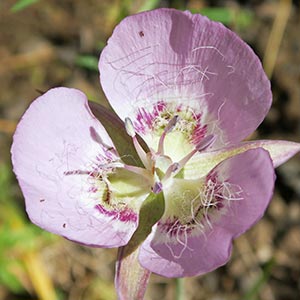Calochortus longebarbatus
Calochortus apiculatus
long-bearded mariposa lily, long-bearded sego-lily, long-hair star-tulip, longbeard mariposa lily
Baker's mariposa-lily, point mariposa-lily, point-tip mariposa lily, pointedtip mariposa lily, three-spot mariposa-lily
usually not branching, 1–3 dm, proximal internodes very short;
bulblet in axil of cauline leaf at or below ground surface.
usually not branching, straight, scapelike, stout, 1–3 dm.
single;
basal persistent, 2–3 dm;
blade linear.
basal 1–3 dm × 5–15 mm, usually shorter than stem.
1–4-flowered.
subumbellate, 1–5-flowered;
bracts 2–several, lanceolate to linear, unequal, 1–5 cm, apex acuminate;
peduncle stout, becoming strongly deflexed in fruit.
erect;
perianth open, campanulate;
sepals ovate-lanceolate, 15–20 mm, apex acuminate;
petals light pink to ± lavender, with red-purple adaxial crescent distal to gland, widely obovate-cuneate, 20–30 mm, not ciliate, with a few long hairs;
glands bordered proximally by ciliate membrane, distally by short hairs;
filaments twice length of anthers;
anther apex obtuse to abruptly short-tipped.
erect or spreading;
perianth yellowish white, sometimes streaked with purple, open, campanulate;
sepals shorter than petals;
petals oblong-lanceolate, clawed, adaxial surface densely hairy, margins fringed laterally and moderately bearded on proximal 1/2 distal to claw with slender, flexuous hairs, apex acute or obtuse;
glands short, nearly round, depressed, typically bordered proximally by dark-colored, deeply fringed membrane, adaxial surface covered with short, thick hairs;
filaments shorter than or equaling anthers;
anthers lanceolate, apex long-apiculate.
erect, 3-winged, ellipsoid to ± globular, 2–3 cm.
nodding, 3-winged, ellipsoid, apex acute.
light brown, irregular.
light brown, irregular.
= 20.
Calochortus longebarbatus
Calochortus apiculatus
recent collections of calochortus longebarbatus from oregon exhibit intergradation in the characters that heretofore have been thought to distinguish the following two varieties (k. l. chambers pers. comm.), and their continued recognition may prove unwarranted
Varieties 2 (2 in the flora).
(Discussion copyrighted by Flora of North America; reprinted with permission.)
1. Perianth obconic-campanulate, petals not sharply bent at gland; basal leaves not reddish at base. | var. longebarbatus |
1. Perianth broadly campanulate, petals sharply bent at gland; basal leaves reddish at base. | var. peckii |


